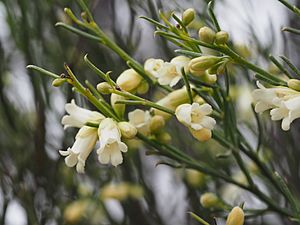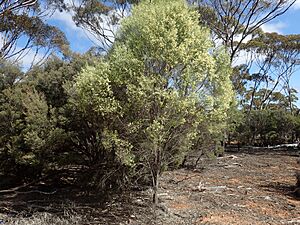Eremophila interstans facts for kids
Quick facts for kids Eremophila interstans |
|
|---|---|
 |
|
| Eremophila interstans subsp. interstans leaves and flowers | |
| Scientific classification | |
| Genus: |
Eremophila (plant)
|
| Species: |
interstans
|
| Synonyms | |
|
Pholidia interstans S.Moore |
|
Eremophila interstans is a type of flowering plant. It belongs to the figwort family, called Scrophulariaceae. This plant grows only in Australia, which means it is endemic there. You can find it as a shrub or a small tree in Western Australia and South Australia. It has thin leaves with a hooked tip and pretty white or cream-colored flowers.
Contents
What Eremophila interstans Looks Like
Eremophila interstans can grow in different ways. Sometimes it looks like a broom, growing up to 2.5 meters (8 feet) tall. It has many branches that start close to the ground. Other times, it's a round shrub or a small tree, reaching up to 6 meters (20 feet) tall.
Its branches point upwards and feel rough and wrinkled. The leaves grow one after another along the branches. They are long and thin, about 2 to 21.5 millimeters (0.1 to 0.8 inches) long. They are also narrow, about 0.5 to 1.2 millimeters (0.02 to 0.05 inches) wide. The leaves can feel rough and sometimes have a sticky resin on them.
Flowers and Fruits
The flowers grow alone or in small groups of up to four. They sit on flat, sticky stalks that are about 2.5 to 4 millimeters (0.1 to 0.2 inches) long. Each flower has five cream-colored sepals. Sepals are like small leaves that protect the bud. These sepals are mostly smooth and sticky, about 3 to 6.5 millimeters (0.1 to 0.3 inches) long. They can sometimes have a reddish color.
The petals are about 6 to 10 millimeters (0.2 to 0.4 inches) long. They are joined together at the bottom to form a tube. This petal tube is usually white or cream-colored, but sometimes it can be lilac. Both the inside and outside of the flower tube and its petal parts are hairy. The four stamens, which are the parts that produce pollen, are completely hidden inside the petal tube.
This plant usually flowers from August to December. After the flowers, oval-shaped fruits grow. These fruits have a hard, crusty covering and are about 2 to 3.5 millimeters (0.1 to 0.14 inches) long.

Naming and History of Eremophila interstans
This plant was first officially described in 1899 by Spencer Le Marchant Moore. He named it Pholidia interstans. This description was published in a science journal called Journal of the Linnean Society, Botany.
Later, in 1904, two other scientists, Ludwig Diels and Ernst Georg Pritzel, changed its name to Eremophila interstans. When Moore first described the plant, he noticed it seemed to be a mix between two plant groups, or genera, that were known at the time: Eremophila and Pholidia. Because it seemed to stand "between" these two groups, he chose the specific epithet interstans. This name comes from the Latin words inter, meaning "between," and stans, meaning "standing."
Different Types of Eremophila interstans
There are two main types, or subspecies, of Eremophila interstans:
- Eremophila interstans subsp. interstans: This type is a shrub or small tree. Its leaves spread out from the branches. It has cream-colored flowers that appear between August and early October.
- Eremophila interstans subsp. virgata: This type is a broom-shaped shrub. Its leaves often stick close to the branches because of resin. It has white flowers that appear between October and December.
Where Eremophila interstans Grows
Eremophila interstans subsp. interstans is very common. You can find it in red sand, sandy loam, or clay soils. It grows between Balladonia and Southern Cross in Western Australia. There is also a separate group of these plants on the Uno Range of the Eyre Peninsula in South Australia.
Subspecies virgata grows in clay or sandy loam soils. It is found between Norseman and Menzies in Western Australia.
Conservation Status
Both types of Eremophila interstans are considered "not threatened." This means they are not currently in danger of disappearing. The Western Australian Government's Department of Parks and Wildlife has given them this classification.
Growing Eremophila interstans in Gardens
This plant is popular for gardens because it has a soft look and many cream-colored or lilac flowers in spring. It makes a beautiful feature plant. Since it can grow into a large shrub or even a small tree, it's good for creating a windbreak. Just make sure to plant it where it has plenty of space to grow.
You can grow new plants from cuttings taken from a young plant. You can also grow it by grafting it onto Myoporum rootstock. It can grow in most types of soil, even heavy clay. It does well in full sun or a partly shaded spot. This plant is also good at handling both dry weather and frost.

